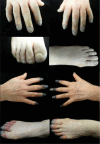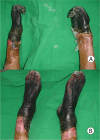Determining the timing and extent of amputation in symmetrical peripheral gangrene: a report of three cases from Korea
- PMID: 40704191
- PMCID: PMC12277902
- DOI: 10.12771/emj.2024.e77
Determining the timing and extent of amputation in symmetrical peripheral gangrene: a report of three cases from Korea
Abstract
Symmetrical peripheral gangrene is a severe condition marked by symmetric acral necrosis without obstruction of the major blood vessels. This case report examines the critical decisions involved in choosing between early and delayed amputation, as well as determining the extent of the necessary amputation. We present three cases: one involving antiphospholipid syndrome, another with disseminated intravascular coagulation, and a third associated with diabetes mellitus. All three cases ultimately required amputation due to symmetrical peripheral gangrene. In the first two cases, amputation was delayed, which is typically advantageous as it allows for the clear demarcation of necrotic tissue. However, in the third case, where infection was evident, immediate amputation was necessary despite the patient's overall poor health.
Keywords: Amputation; Antiphospholipid syndrome; Diabetes mellitus; Disseminated intravascular coagulation; Gangrene.
© Copyright 2025 Ewha Womans University College of Medicine and Ewha Medical Research Institute.
Conflict of interest statement
No potential conflict of interest relevant to this article was reported.
Figures



Similar articles
-
Lumbar sympathectomy versus prostanoids for critical limb ischaemia due to non-reconstructable peripheral arterial disease.Cochrane Database Syst Rev. 2018 Apr 16;4(4):CD009366. doi: 10.1002/14651858.CD009366.pub2. Cochrane Database Syst Rev. 2018. PMID: 29658630 Free PMC article.
-
Non-surgical interventions for preventing contralateral tissue loss and amputation in dysvascular patients with a primary major lower limb amputation.Cochrane Database Syst Rev. 2024 Aug 28;8(8):CD013857. doi: 10.1002/14651858.CD013857.pub2. Cochrane Database Syst Rev. 2024. PMID: 39193872
-
Infusion techniques for peripheral arterial thrombolysis.Cochrane Database Syst Rev. 2021 Nov 17;11(11):CD000985. doi: 10.1002/14651858.CD000985.pub3. Cochrane Database Syst Rev. 2021. PMID: 34786692 Free PMC article.
-
Is Dissection and Preservation of Adherent Popliteal Vessels From a Posterior Soft Tissue Mass Associated With a Higher Proportion of Local Recurrence in Patients With a Distal Femoral Osteosarcoma?Clin Orthop Relat Res. 2023 Nov 1;481(11):2167-2176. doi: 10.1097/CORR.0000000000002775. Epub 2023 Aug 1. Clin Orthop Relat Res. 2023. PMID: 37527334 Free PMC article.
-
Interventions for treating gas gangrene.Cochrane Database Syst Rev. 2015 Dec 3;2015(12):CD010577. doi: 10.1002/14651858.CD010577.pub2. Cochrane Database Syst Rev. 2015. PMID: 26631369 Free PMC article.
References
Publication types
LinkOut - more resources
Full Text Sources

